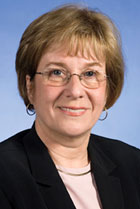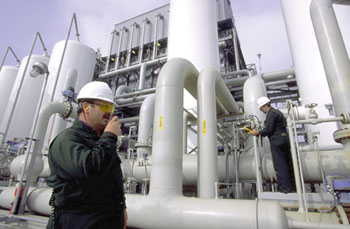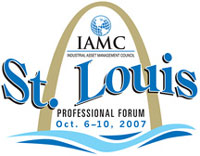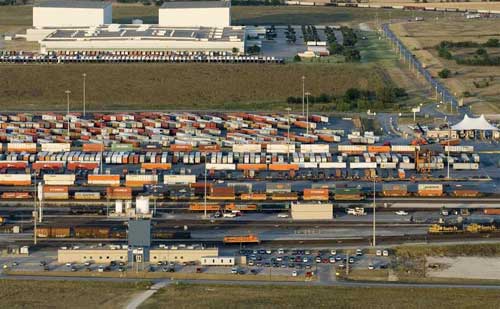
IAMC INSIDER

Name:
Susan Reber
Title & Organization:
Portfolio: Air Products has over 1,000 facilities, 20 percent owned and 80 percent leased, in 40 states and 40 countries outside the U.S. There are approximately 20,000 employees, almost half outside the U.S.
What does your company manufacture?
To whom do you report?
How many years have you worked in the profession?

Where and what did you study?
Describe the most important transaction or project for which you were responsible.
What is the biggest professional challenge you face on a regular basis?
How is the role of manager of real estate evolving?
Which technology do you consider to be essential in your professional life?
What is the value of IAMC membership to you?

IAMC PROFESSIONAL
FORUM SPECIAL REPORT
FORUM SPECIAL REPORT
"The Lowdown on Logistics"
For the latest in air cargo, rail and intermodal development trends, Forum attendees gained insights from one another and from speakers Tony Love, assistant vice president, real estate, for Union Pacific Railroad Co.; Mike Maynard, aviation project manager for Wilbur Smith Associates, Mike Berry, president of Hillwood Properties; and moderator Charles McSwain of CSX.
McSwain noted that environmental, social and quality issues in China may be beginning to level out the manufacturing playing field. But efficiencies in supply chain management can be another leveling factor.
Love of Union Pacific noted that amid, skyrocketing demand on rail and tight capacity, UP is making record investments and going green at the same time. The mainline railroads have invested over $48 billion in infrastructure and equipment over the past seven years, and anticipate spending over $9 billion in 2007.
Those changes could have an enormous effect considering that intercity freight is expected to grow from 15.3 billion tons today to 37.2 billion tons by 2035. Train miles already were up by over 60 percent in 2005, even though miles of actual rail have shrunk.
Reflecting the frustrations of many in the room, Love said, "On the UP network, it's tough to get a switch off the main line. Many corridors are restricted or controlled access." But he warned against the threat of rail re-regulation looming in the nation's capital.
"Re-regulation is a downward spiral," he said, meaning lower rail revenues, constrained capacity and diminished investment in rail infrastructure. "Re-regulation would mean less rail capacity when more is needed," he said.

Hillwood's AllianceTexas development today is host to 27 million sq. ft. (2.5 million sq. m.) of distribution space, and sees as many container lifts per year as the Port of Houston.
Air Cargo and Inland Ports Make Headway
In addition to well-known industrial cargo gateways, Maynard pointed out that over the past 15 years the industry has identified specialized air cargo pathways: Huntsville, Ala., and Luxembourg for aerospace and automotive goods; San Francisco and Tokyo; Hong Kong and Columbus, Ohio, twice a week moving textiles; perishables between Miami and Bogota, Colombia; and two sets of cities serving the oil and gas sector: Jeddah and Houston, and the Seattle-Calgary-Prestwick-Luxembourg chain.
Berry of Hillwood had a unique perspective on intermodal and inland port development, having overseen the growth of the 17,000-acre (6,880-hectare) Alliance Texas project over the past 15 years. He noted that in 1995, no major steamship services called at a mainland China port, while today all major U.S. seaports claim China as their leading trade partner.
"L.A.-Long Beach is still the granddaddy," lifting 15 million TEUs annually and accounting for 58 percent of imported container traffic, he said. But use of the Suez Canal and the current expansion of the Panama Canal are causing U.S. east coast ports to position for growth. Some have experienced it already, with Norfolk and Charleston accounting for five percent of imports and Savannah and Houston earning two percent each.
Thus the stage is set for inland port developments like Alliance and others in Columbus, Ohio; Memphis; Chicago; Kansas City and San Antonio, driven by rail-designated intermodal ramps, Interstate highway adjacency and large population bases.
Berry noted the expansion of the Lazaro Cardenas port in Mexico, but said most in the industry see that port servicing the Mexican interior market, "simply because it will take more time for that rail infrastructure to improve." Meanwhile, he said, "The Port of Topolobampo is one nobody talks about much anymore, but it could be a long term development opportunity.
Solution Centers
Following table discussions surrounding logistics issues, McSwain of CSX responded to general frustration with inability to get new rail service.
"The reason there are new guidelines is those railroads are becoming the new Interstates," he said. "They're single-lane roads, and switching blocks train movements."
Branch lines, industrial parks and short lines are part of the answer, he said. Asked how it's possible to still adequately serve smaller customers, Love of UP said, "For a Class I railroad, it makes more sense to be a long-haul interstate carrier. We have the most carload business of any class I. It's more expensive, and the work is more intensive to do. There has to be a cooperative effort among businesses."
Integrated logistics parks may be one answer.
"Drag 15 or 20 cars onto a siding, and let the logistics park switch to those individual customers – that's a solution that works for everybody," said Love.
— Adam Bruns
